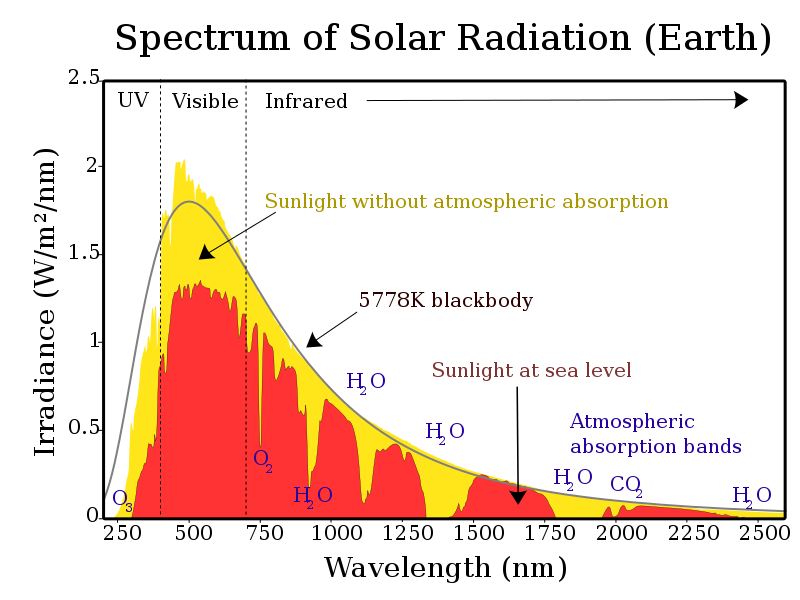Αρχείο:Solar spectrum en.svg

Το μέγεθος αυτής της PNG προεπισκόπησης αυτού του SVG το αρχείο: 800 × 600 εικονοστοιχεία. Άλλες αναλύσεις: 320 × 240 εικονοστοιχεία | 640 × 480 εικονοστοιχεία | 1.024 × 768 εικονοστοιχεία | 1.280 × 960 εικονοστοιχεία | 2.560 × 1.920 εικονοστοιχεία.
Εικόνα σε υψηλότερη ανάλυση (Αρχείο SVG, ονομαστικό μέγεθος 800 × 600 εικονοστοιχεία, μέγεθος αρχείου: 49 KB)
Ιστορικό αρχείου
Κλικάρετε σε μια ημερομηνία/ώρα για να δείτε το αρχείο όπως εμφανιζόταν εκείνη τη στιγμή.
| Ώρα/Ημερομ. | Μικρογραφία | Διαστάσεις | Χρήστης | Σχόλια | |
|---|---|---|---|---|---|
| τελευταία | 16:10, 13 Μαΐου 2019 |  | 800 × 600 (49 KB) | Tuvalkin | It's W, not kW, as further discussed: Reverted to version as of 20:57, 21 February 2016 (UTC) |
| 14:13, 25 Φεβρουαρίου 2019 |  | 800 × 600 (49 KB) | Tuvalkin | W → kW, as dicussed | |
| 20:57, 21 Φεβρουαρίου 2016 |  | 800 × 600 (49 KB) | BenRG | Replace 5250°C blackbody (seemingly miscalculated anyway) with standard 5778K blackbody; center-align captions; use Unicode ² instead of SVG superscript to fix rendering problems | |
| 22:21, 7 Ιανουαρίου 2015 |  | 800 × 600 (50 KB) | Bendhoward | The Y-axis units were changed at some point to W/m^2, which is not correct. The units have been changed back to W/m^2/nm, in accordance with the units of the X-axis. | |
| 22:25, 4 Σεπτεμβρίου 2014 |  | 800 × 600 (50 KB) | TxBangert | ... changed ^2 to superscript | |
| 22:18, 4 Σεπτεμβρίου 2014 |  | 800 × 600 (50 KB) | TxBangert | fixed minor errors in how Wikipedia renders svg image | |
| 10:28, 4 Σεπτεμβρίου 2014 |  | 800 × 600 (50 KB) | TxBangert | Updated the text to bring it in more in line with other European versions of this graph. W/m2/nm on the y axis is wrong. The units are simply W/m2, the x axis is nm. | |
| 14:50, 4 Μαρτίου 2013 |  | 800 × 600 (50 KB) | Arbeck | Typo corrected - Atmosphere | |
| 15:44, 14 Φεβρουαρίου 2013 |  | 800 × 600 (50 KB) | Arbeck | Typo corrected: visible | |
| 15:44, 14 Φεβρουαρίου 2013 |  | 800 × 600 (50 KB) | Arbeck | Typo correctedvisible |
Συνδέσεις αρχείου
Τα παρακάτω λήμματα συνδέουν σε αυτό το αρχείο:
Καθολική χρήση αρχείου
Τα ακόλουθα άλλα wiki χρησιμοποιούν αυτό το αρχείο:
- Χρήση σε ca.wikipedia.org
- Χρήση σε de.wikipedia.org
- Χρήση σε en.wikipedia.org
- Χρήση σε es.wikipedia.org
- Χρήση σε eu.wikipedia.org
- Χρήση σε hak.wikipedia.org
- Χρήση σε hi.wikipedia.org
- Χρήση σε hu.wikipedia.org
- Χρήση σε ig.wikipedia.org
- Χρήση σε ja.wikipedia.org
- Χρήση σε ms.wikipedia.org
- Χρήση σε sk.wikipedia.org
- Χρήση σε te.wikipedia.org
- Χρήση σε uz.wikipedia.org
- Χρήση σε vi.wikipedia.org










